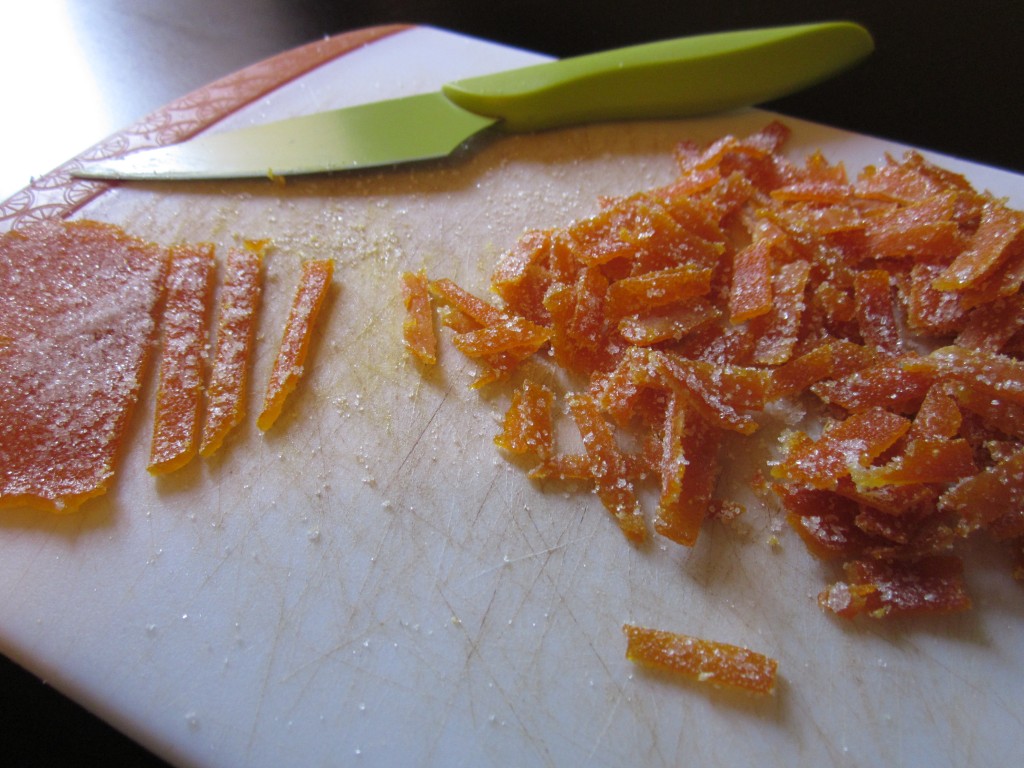Culture
The Hipster’s Cookbook: Candied Orange Peel

Every week in The Hipster’s Cookbook, Meghan Bongartz shows you how to make delicious food on a tight budget.
If you’ve ever wanted to make a recipe that calls for candied orange peel or ginger, you probably already know that candied anything is exorbitantly expensive. I think I purchased candied ginger from the spice section of Jewel once. It cost $15 for about an ounce of ginger, and after that I learned how to make it myself. It can be a lengthy process, but it’s actually not very difficult and it’s definitely a lot cheaper. You can also make much more than an ounce in one go, which means you won’t run into trouble when you have a recipe that calls for a cup of candied cherries.
You can candy or crystallize just about any fruit (probably most non-leafy vegetables, too, but I’m not dying for sugar coated bell pepper anytime soon). The ones that tend to turn up the most commonly include ginger, citrus peel, cherries, and pineapple, and the same technique will work for all of these – essentially just boiling the fruit in sugar syrup. On that note, the difference between candying and crystallizing is simply whether you put an extra coat of sugar on at the end (no for candied, yes for crystallized). Both varieties are useful to have on hand for baked goods, granola, a sweet addition to salads, or just for snacking on. They can be stored in an airtight container for a fairly long time at room temperature, and longer in the refrigerator. I’ve never done an experiment to see just how long it takes before candied fruit goes bad, but I’ve never had a problem with it.
Usually I go with candied ginger because the extra makes an easy gift for my grandma, who says that it helps her digestion. A couple of weeks ago, though, I made a cake that called for a metric ton of crystallized orange peel in the frosting, though, so that’s what you get to see today. When I made this, I cut the pith (the white part) out of the orange peel pretty methodically because I didn’t want it to be too heavy in the frosting and because the pith is the bitter part of the peel. If you don’t want to spend an hour peeling your orange peel, you can leave some or all of the pith, or you can blanch the orange peel first by boiling it in plain water for a couple minutes and then putting it in a bowl of ice water immediately. If you’re working with cherries, ginger, or pineapple, you don’t have to worry about that (but you should peel your ginger; the peel is gross).
——
Candied Orange Peel
3 navel or Valencia oranges
2 cups granulated sugar
4 cups water
2 cups ice water
Additional granulated sugar to dust
1) Wash and peel the oranges, then gently cut out most of the pith, leaving the orange colored outer peel.
2) Boil two cups of water and cook the orange peel for 3-5 minutes. Drain and immerse in a bowl of ice water.
3) While the orange peel is in the ice water, bring two cups of water and 2 cups of sugar to a rolling boil.
4) Drain the ice water and add the orange peel to the sugar syrup. Reduce heat to medium low and simmer for about an hour, or until the orange peel becomes translucent.
5) Drain and set on a sheet of wax paper. Dust with additional sugar if you’d like to make crystallized orange peel. Let dry a minimum of 3-4 hours or overnight, covering gently with a second sheet of wax paper if you will be leaving it out more than a few hours.
6) Chop to desired size using a sharp knife.